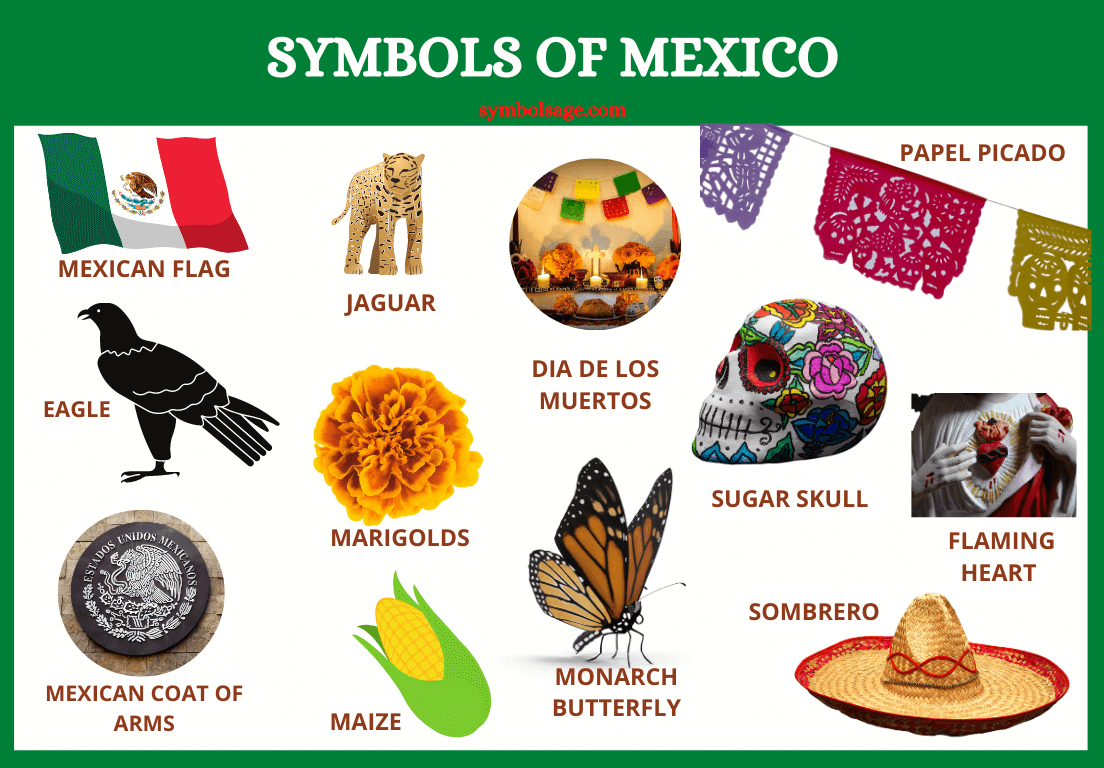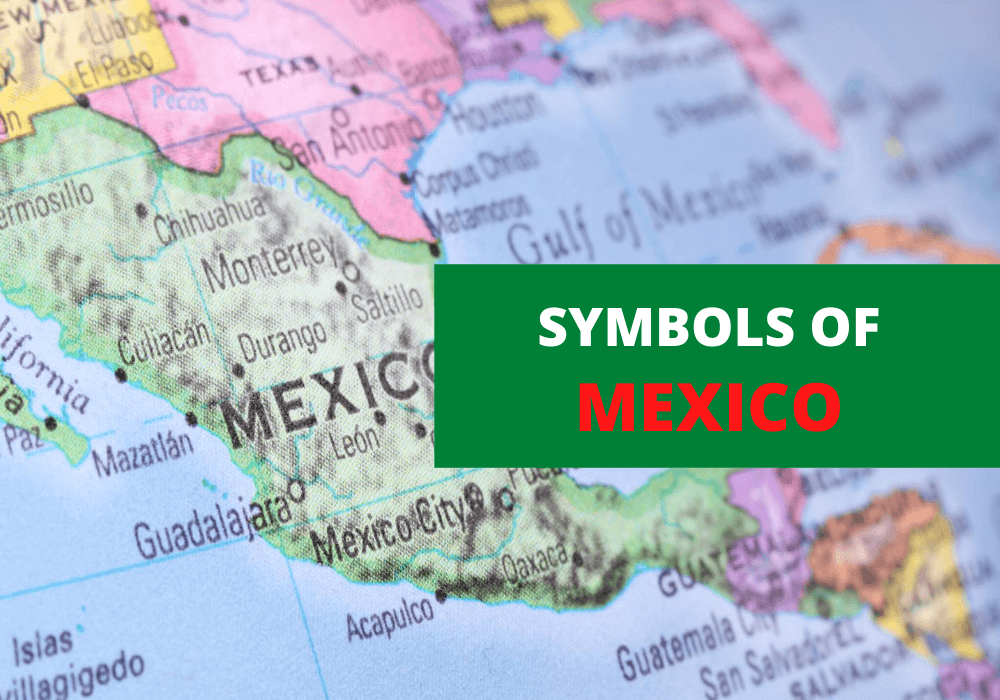
Table of Contents
Mexico has a rich history that includes great ancient Mesoamerican civilizations of the Aztecs and Mayans; as well as the influence of the European western world with the arrival of the Spaniards. The result is a culture rich in folklore, religion, art, and symbols.
Here are some of the most significant symbols of Mexico.
- National Day of Mexico: 16th September, commemorating independence from Spain
- National Anthem: Himno Nacional Mexicano (Mexican National Anthem)
- National Bird: Golden Eagle
- National Flower: Dahlia
- National Tree: The Montezuma Cypress
- National Sport: Charreria
- National Dish: Mole Sauce
- National Currency: Mexican Peso
Mexican Flag
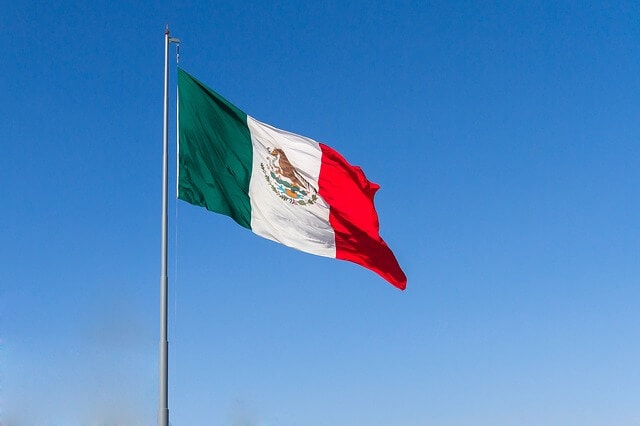
The national flag of Mexico features three vertical stripes, with the coat of arms of Mexico in the center. The tricolor flag features green, white and red, originally representing independence, religion and union respectively. Today, the three colors are meant to symbolize hope, unity and the blood of national heroes. The three colors are also the national colors of Mexico, which adopted them after they acquired independence from Spain.
Coat of Arms
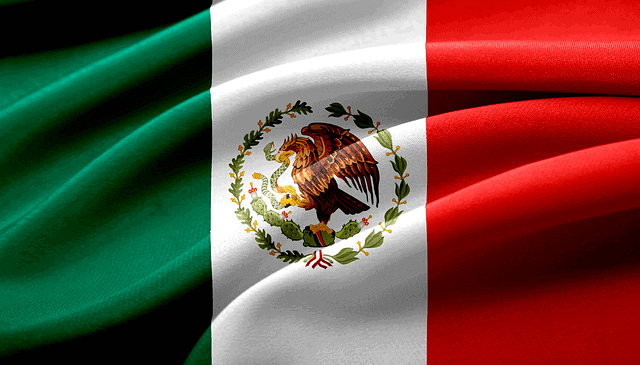
The coat of arms of Mexico is inspired by the formation of the ancient capital Tenochtitlan. According to Aztec legend, the nomadic tribe was wandering through the land waiting for a divine sign to show them where they should build their capital.
It’s said that the eagle devouring a snake featured on the coat of arms (known as the Royal Eagle) is a depiction of the divine sign that led the Aztecs to build Tenochtitlan in its location.
Pre-Colombian peoples may have seen the eagle as the sun god Huitzilopochtli, whereas the Spanish could’ve viewed the scene as a symbol of good overpowering evil.
Sugar Skull
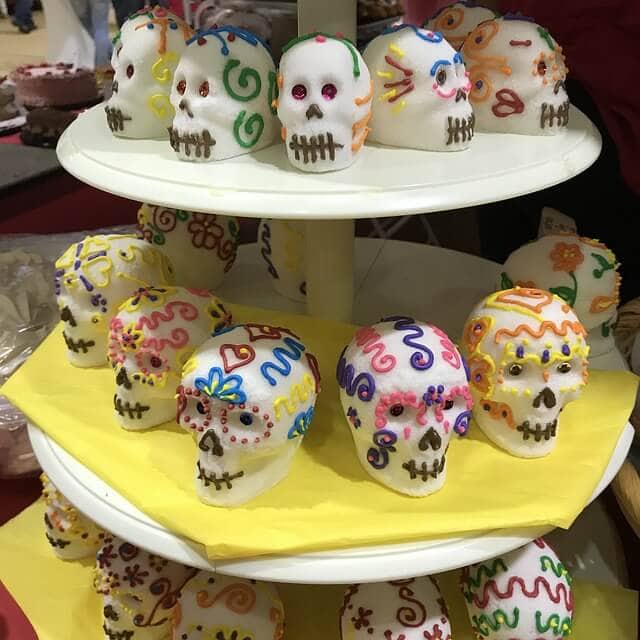
Dia de Los Muertos (Day of the Dead) is a holiday to honor the dead, and is one of the most significant celebrations in Mexico. The national holiday takes place from the 1st of November, but celebrations are held in the days before and after.
The colorful Calaveritas de azucar (sugar skull) are synonymous with the holiday. These are sculptured skulls that are traditionally made of sugar, now sometimes made of clay or chocolate, and used to decorate altars dedicated to the dead. The symbol has also expanded to Catrina face painting, where people are made-up with white face paint and colorful decals to mimic sugar skulls.
Cempasuchil Flowers
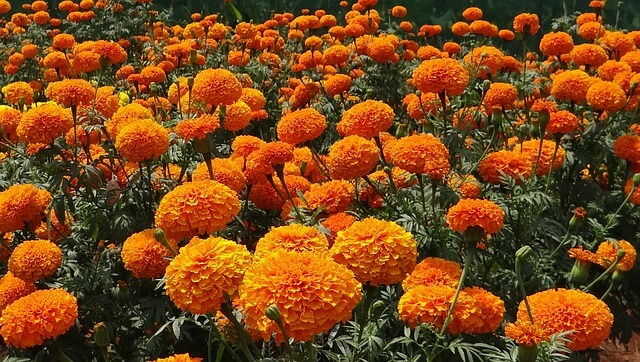
The significance of Cempasuchil flowers (Mexican Marigolds) dates to a romantic Aztec myth. The legend is about two young lovers – Xótchitl and Huitzilin – who would regularly hike to the top of a mountain to leave flowers as an offering to the sun god, and prove their love for one another.
When Huitzilin was killed in battle, Xótchitl prayed to the sun god to reunite them on earth. Moved by her prayers and offerings, the sun god transformed her into a golden flower and reincarnated her lover as a hummingbird. This legend is thought to inspire the belief that Cempasuchil flowers guide spirits home, which is how they came to be the flowers used as offerings on the Day of the Dead.
Perforated Paper
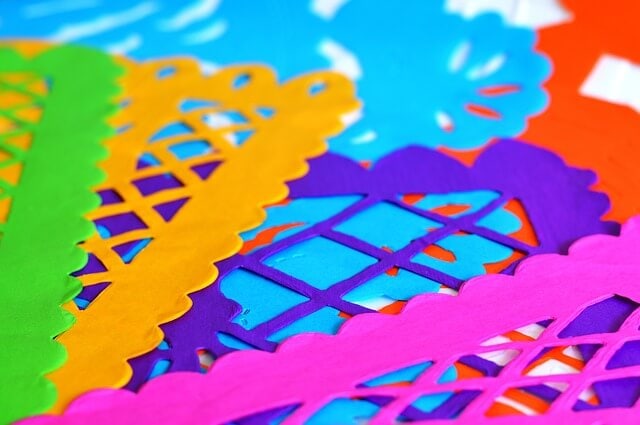
Papel Picado (perforated paper) are artfully cut sheets of tissue paper used as decoration during secular and religious celebrations. A closer look will reveal intricate designs that usually include symbols relevant to a particular celebration.
For example, during the Day of the Dead, the tissue can be cut into sugar skull shapes, but at Christmas, the paper is cut to show the Nativity Scene, doves and angels. Paper colors can also have different meanings, particularly on Day of the Dead celebrations.
Orange is symbolic of mourning; purple is related to the Catholic religion; red depicts women who died in childbirth or warriors; green is symbolic of the young; yellow is used for the elderly; white for children, and black paper symbolizes the underworld.
Butterfly

Butterflies are significant symbols in many cultures, and in Mexico, Monarch butterflies are revered because they flock to the country by the millions as part of their yearly migration. In Mexican folklore, Monarch butterflies are believed to be the souls of the deceased. As such, the monarch butterfly is a common decoration used in Day of the Dead celebrations.
Pre-colonial cultures also ascribed meanings to butterflies. White butterflies indicated positive news; black butterflies symbolized bad luck, and green butterflies were symbols of hope. Butterflies are a common motif in the pottery and textiles of Mexican folk art.
Jaguar
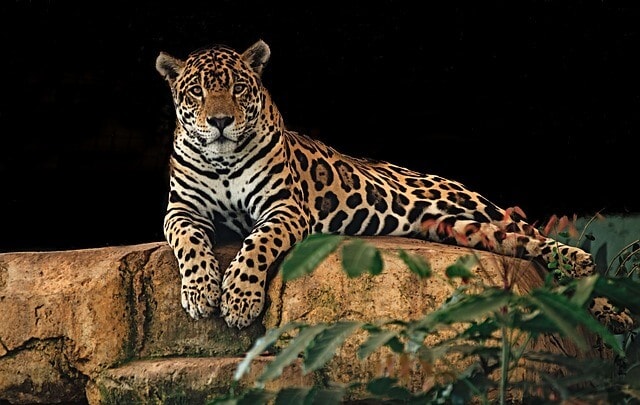
Jaguars are one of the most revered animals in Mesoamerican cultures. The Mayans used the symbol of the Jaguar for many things. Its dominance as a predator saw it associated with ferocity, power, and strength. For this reason, the jaguar was commonly used to adorn the shields of Mayan warriors.
As jaguars are nocturnal, they were also revered for their ability to see in darkness. For this reason, they were also associated with deep perception – especially in an introspective sense – and foresight. The jaguar was the spirit animal of the Aztec god of sorcery and the night – Tezcatlipoca. Tezcatlipoca’s stone is obsidian, a reflective black stone that was used as a mirror to invoke the visionary powers of the jaguar.
Feathered Serpent
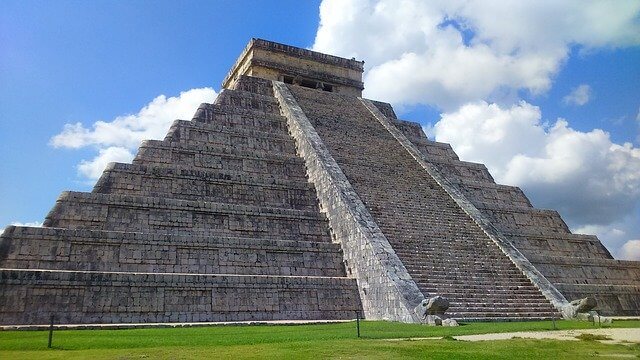
Kukulkan is the feathered serpent deity worshipped in many Mesoamerican cultures, particularly the Maya. Believed to be the creator of the cosmos, the feathered serpent is among the most important gods. The principal temple in the ancient city of Chichen Itza is known as the temple of Kukulkan. The steps are even designed to show the snake making its way from the top of the temple to the ground as the shadow moves across the steps during the equinox.
Kukulkan’s feathers represent the serpent’s ability to soar through the heavens as well as on earth. Its all-seeing ability is also why it is known as the vision serpent. The shedding of a snake’s skin is also associated with rebirth, and Kukulkan is often used as a symbol of renewal.
Mayan Sacred Tree

The Ceiba (Mayan Sacred TreeI) symbolizes the connection between the three levels of the Mayan universe. The underworld is represented by the roots; the trunk depicts the middle world of the humans, and the branches reach into the heavens. The sacred tree shows five quadrants, which represent the cardinal directions of the earth according to Mayan belief – north, south, east, west, and the center.
Each direction has its own meaning. East is linked to ideas of initiation and the color red; west is linked to duality and the color black; north is linked to diminishment and the color white, and south is linked to increasing harvest and the color yellow.
Sombrero
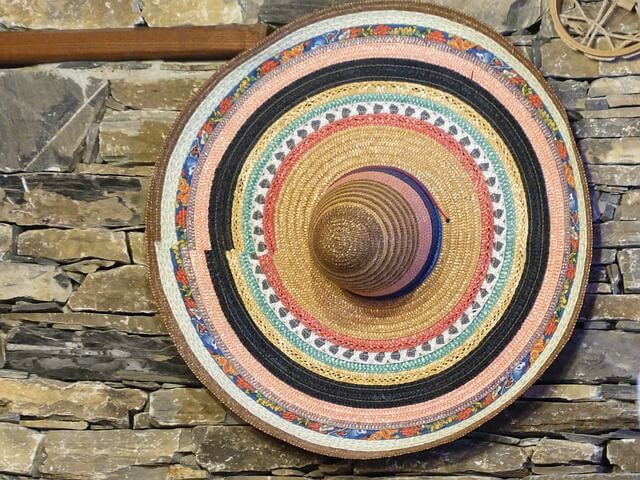
Sombrero, which means hat or shadower in Spanish, is a broad-brimmed hat made of felt or straw typically worn in Mexico, Spain and some southwestern parts of the United States. This type of hat is famous for its large size, pointed crowns and the chin strap. The purpose of sombreros is to protect the wearer from the harsh effects of the sun, especially in sunny and dry climates like those found in Mexico.
Eagle

In Aztec belief, the eagle is symbolic of the sun. An eagle in flight represented the journey of the sun from day to night. Parallels were also drawn between the swooping of an eagle and the setting of the sun.
As a soaring predator, the eagle was also associated with strength and power. The eagle is the symbol associated with the 15th day on the Aztec calendar, and those born on this day were seen to have the qualities of a warrior.
Maize
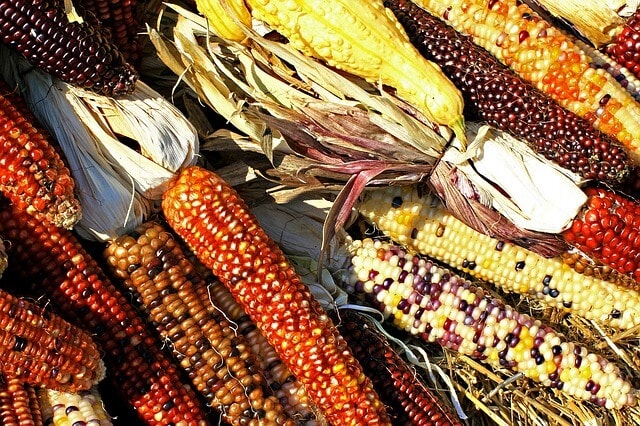
Maize or corn was one of the primary crops in many Mesoamerican cultures, and so it was revered for its nourishing power. In Aztec culture, each stage of the plant’s life was celebrated with festivals and offerings. The god of rain (Tlaloc) that nourished the crop was even depicted as the ears of corn. Pre-colonial stocks of maize were also more colorful than the corn we’re used to today. Corn was white, yellow, black, and even purple.
Mayan beliefs tie the creation of man with corn. Legend has it that white corn was used for human bones, yellow corn made the muscles, black corn was used for hair and eyes, and red was used to make blood. In many rural areas, maize is not only seen as an important food source, but it is also used as an important life-giving symbol in ceremonies and rituals.
Cross
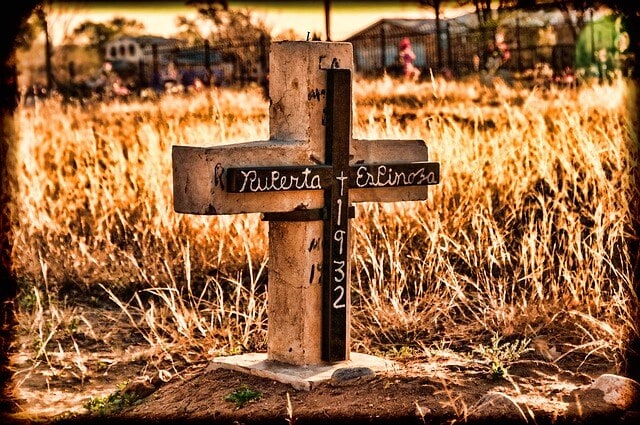
The cross is a symbol that shows the fusion of cultures in Mexico as it is significant in pre-colonial cultures as well as the Roman Catholic culture brought by the Spaniards. In Mayan belief, the four points of the cross represent the directions of the winds which is crucial to life and good crops. It is also symbolic of dawn, darkness, water, and air – the important energies that come from all extremes of the earth.
In Catholicism, the cross or crucifix is a symbolic reminder of the death of Jesus – the ultimate sacrifice that God made for his people – and the redemption that Catholics are offered as a result of his passion, death, and reincarnation. In Mexico, the cross is typically made of clay or tin and decorated in the style of colorful Mexican folk art.
Flaming Heart
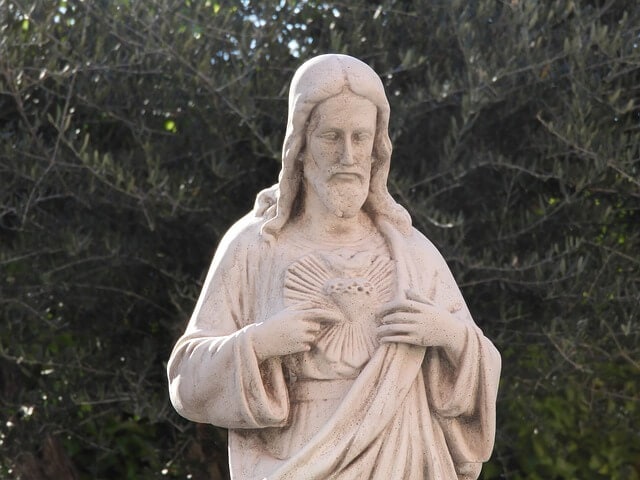
The crucifix in Mexico often has a deep red heart in its center. This is called the flaming heart, and in other Roman Catholic countries, it’s called the Sacred Heart of Jesus. It symbolizes Jesus’ divine love for humanity. The flaming heart is often used as a token or decorative motif on its own. Sometimes it is depicted with flames, which represent passion, or the crown of thorns which Jesus wore when he died on the cross. Like the crucifix, it is used as a reminder of the sacrifice Jesus made in order for Catholics to be redeemed from their sins.
Wrapping Up
Symbolism in Mexico is varied because of the rich history and influences from many different cultures and beliefs. Some of the symbols listed above are official symbols, while others are unofficial cultural icons. To learn more about the symbols of other countries, check out our related articles:
